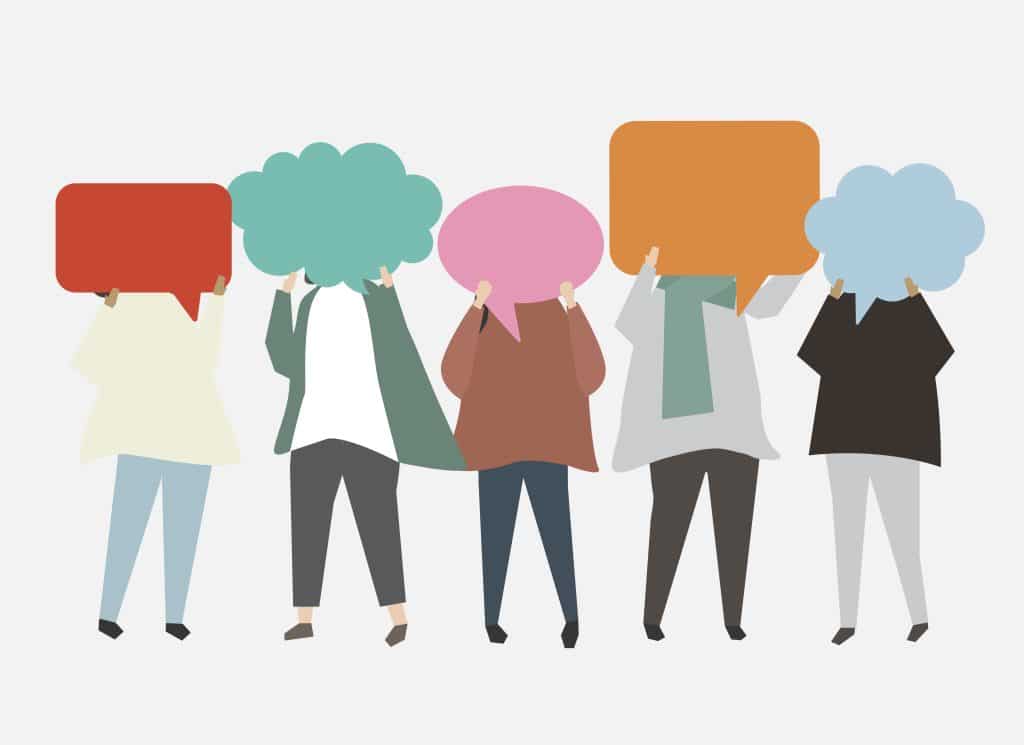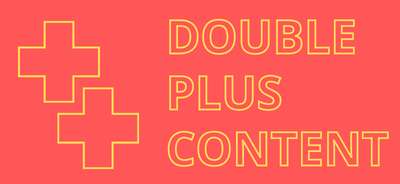Figures of speech in marketing are everywhere, but we rarely reflect over them. All we see is compelling, creative, innovative or beautiful copy. Fact is, we all use figures of speech daily without reflecting over them. Take the classic metaphor, for instance. We say that a chair has legs, time moves and a nail has a head. We use these figures as a way to associate similarities (head, legs etc) because they make things more relatable and understandable
Literature is littered with figures of speech, as well as politics. The iron curtain wasn’t an iron wall dividing the Soviet bloc from the West. But it was a powerful metaphor to explain the division between two political systems.
Figures of speech in marketing are extremely powerful. They can also come in handy in your content production. Not just to spice things up, but to evoke emotions in the reader, explain complex processes or products, or show them that you know them.
In this article, I’ll go through and explain some of my favorite figures of speech and how they work. I will also add a few examples on how you can use them in your marketing efforts.
Use metaphors to explain and create emotion
Metaphors add depth, relatability, and vivid imagery to your writing. Essentially, a metaphor is a figure of speech that draws a connection between two seemingly unrelated things to create a deeper understanding or evoke strong emotions.
Constructing a metaphor involves identifying a key characteristic or quality of the subject you want to describe and comparing it to something else that shares that same quality. The comparison is often made using words like “is” or “are.” For instance, if you’re marketing a luxurious car, you might say “Our car is a sleek panther, swift and elegant on the road.” Here, you’re connecting the qualities of speed and elegance from a panther to your car.
Here’s how you can use metaphors in your marketing copy:
Engage emotions: Metaphors appeal to emotions and imagination, making your content more memorable and relatable. By linking your product or idea to something familiar or emotionally resonant, you create a stronger connection with your audience.
Simplify complex concepts: Metaphors can simplify complex or technical ideas by comparing them to something more easily understood. For example, if you’re explaining a complex software process, you might compare it to assembling a puzzle.
Create visual appeal: Metaphors create vivid mental images, allowing readers to picture and feel what you’re describing. This can make your descriptions more vibrant and compelling.
Storytelling: Metaphors can be woven into storytelling, making narratives more engaging. They can serve as central themes or recurring motifs that tie your content together.
Brand identity: Consistently using specific metaphors can help shape your brand’s identity and messaging. For instance, if you’re marketing an eco-friendly product line, metaphors related to nature and sustainability can reinforce your brand values.
Differentiation: Metaphors can help set your product or service apart from the competition. By drawing unique and imaginative comparisons, you create a distinct image in the minds of your audience.
Personification enhances connection
Personification (not to be confused with personalization) is a neat trick used in writing and content marketing to make things that aren’t human seem more relatable and engaging. It’s like giving objects, animals, or ideas human-like traits to make them feel alive and interesting. One example that pops to mind for me is the sorting hat in Harry Potter. A notable use of personification is when Apple introduced Siri on the iPhone, calling it (her) “Your New Best Friend”

In content marketing, personification can work wonders. Look at these example use areas:
Creating connection: When you make a product or service seem like it has feelings or actions, people can connect with it better. For instance, saying “Our smartphone understands your needs” gives the idea that the phone is like a helpful friend.
Making concepts tangible: Complex ideas can become easier to understand when you give them human qualities. If you’re explaining a difficult software process, you might say “The program learns from your actions,” which makes the software seem like a learning partner.
Eliciting emotions: Personification can trigger emotions. If you’re promoting a cozy cafe, you might say “The aroma of freshly brewed coffee welcomes you,” creating a warm and inviting image.
Storytelling: By giving non-human elements personality, you can weave them into your storytelling. If you’re selling outdoor gear, you could talk about how “The rugged mountains challenge adventurers,” making the mountains a character in your story.
Injecting creativity: Personification adds creativity and flair to your content. If you’re talking about energy-efficient appliances, you could say “The thermostat works tirelessly to save you money.”
Allegory brings out the big ideas in your storytelling
An allegory is like a hidden story within a story. It’s a way of using characters, events, or settings to represent bigger ideas, usually about life, society, or deeper meanings. Imagine it like a puzzle where each part has a special meaning beyond what you see on the surface.
Allegories are really a full story, not just a figure of speech added to content. A good example is the iconic Apple commercial from 1984, depicting the overthrow of conformity and control through the introduction of the Macintosh computer.

In content marketing, allegory can be a really creative tool. Here are some use areas:
Complex messages: If you want to explain a complex idea or message, you can create an allegory. Just like in fables where animals talk and teach us lessons, you can use symbolic characters and situations to help people understand a bigger concept.
Emotional connection: Allegories can tap into emotions. They can make your audience feel a connection because they see the characters or situations going through something relatable, even if it’s symbolic.
Memorable storytelling: Allegories make your content memorable. People tend to remember stories more than plain facts, so using an allegorical story can help your message stick.
Adding depth: If you want to add depth to your brand or product, you can create an allegory that reflects your values or what your product stands for. This gives your content more layers and makes it stand out.
Spark imagination: Allegories encourage your audience to think and interpret. They might start discussions or debates about the hidden meanings in your story, which can create more engagement with your content.
For example, if you’re marketing a new eco-friendly product, you could create a short allegorical story about a polluted land where a hero and their team work to restore nature. This story can symbolize the journey toward a cleaner environment, connecting your product with a larger mission.
Synecdoche – express with less
Synecdoche is a figure of speech where a part of something is used to represent the whole, or the whole is used to represent a part. It’s a way of saying something indirectly by mentioning a related thing. It’s like using a small piece of something to show the entire picture. A good example is when news media is reporting on politics. Instead of saying the president and his administration, they refer to this as the White House. Other, well-established synecdoches are threads = clothes, press = journalists, top brass = people in the highest position.
In content marketing, synecdoches can be used in several ways. Here are some of my favorite ones:
Concise communication: Synecdoches helps you communicate more efficiently. Instead of using a long explanation, you can use a part of something to stand for the whole idea. For example, saying “All hands on deck” to mean everyone’s needed to help.
Memorable messaging: It can make your message stick in people’s minds. When you use a part to represent the whole, it creates a vivid and memorable image that’s easier to remember.
Adding depth: Synecdoche can add depth to your content. It can give a sense of the bigger picture by focusing on a specific detail. If you’re marketing a car, you might say “wheels on the road” to refer to the entire vehicle.
Creating connection: It can help your audience feel more connected. When you use a part that they’re familiar with, it can create a sense of shared understanding and make your message more relatable.
Symbolism: Synecdoche can be symbolic. For example, if you’re marketing a tech product, you could say “a thousand eyes are on our software,” using “eyes” to mean users, which implies watchfulness and attention.
Highlighting features: If you’re promoting a product with a standout feature, you can emphasize that feature using synecdoche. For instance, if you’re selling a camera with exceptional zoom, you might say “our lens captures every detail.”
Anaphora adds power with repetition
Anaphora is a figure of speech where you repeat the same word or phrase at the beginning of successive sentences or phrases. It’s like a rhythm or a pattern that makes your writing or speech more impactful and memorable.
Here are some good examples of anaphoras from company slogans:
- Wrigley’s Doublemint – ‘ Double your pleasure, double your fun.’
- Kit Kat – ‘Have a Break, Have a Kit Kat.’
- Guinness – ‘My Goodness, My Guinness.’
In content marketing, anaphoras can be a great technique to grab attention and create emphasis. Check out these use areas:
Attention-grabbing: When you start multiple sentences with the same word or phrase, it creates a rhythmic pattern that captures your audience’s attention. It’s like a musical beat that draws them in.
Emphasis: Anaphora puts emphasis on the repeated word or phrase. This can make your message stronger and more compelling. For instance, if you’re advertising a sale, you could say, “Save money. Save time. Save big.”
Reinforcing key points: When you repeat a key idea, it reinforces its importance. If you’re marketing a health product, you might say, “Stay active. Stay healthy. Stay you.”
Creating momentum: Anaphora creates a flow that propels your content forward. It can make your writing feel dynamic and energized.
Enhancing memorability: The repetition in anaphora makes your content stick in people’s minds. It’s easier for them to remember your message because of the repetitive structure.
Evoking emotion: By repeating emotional words or phrases, you can evoke specific feelings in your audience. For example, if you’re promoting a travel destination, you could say, “Discover. Experience. Dream.”
Provoke your reader with a paradox
A paradox is a figure of speech that seems to contradict itself or presents a situation that appears to go against common sense, but it actually reveals a deeper truth or complexity. It’s like a little puzzle that makes you stop and think in order to get the true meaning of the phrase or sentence. Consider the classic phrase “Less is more”. Or, an old favorite of mine, attributed to the US baseball player Yogi Berra: “Nobody goes to that restaurant; it’s too crowded”.
In content marketing, paradoxes can be both engaging and thought-provoking. Here are some of my favorite areas:
Grabbing attention: Paradoxes can surprise your audience and make them pay attention. When you present something that doesn’t quite make sense at first, it piques curiosity and makes people want to understand what you’re saying.
Creating intrigue: If you want to make your content more interesting and mysterious, a paradox can work wonders. It makes people pause and wonder how something seemingly contradictory can be true.
Highlighting uniqueness: If you have a product or service with a unique selling point, you can use a paradox to highlight it. For instance, if you’re marketing an energy drink that promises calmness, you might say, “Energize your day with tranquil vigor.”
Stimulating thought: Paradoxes encourage your audience to think deeper. They challenge the usual way of thinking and can spark discussions or reflections.
Emphasizing contrasts: Paradoxes are great for emphasizing contrasts. If you’re promoting a luxury product, you might use a paradox like “Simple elegance. Lavish simplicity.”
Memorability: Because paradoxes are unexpected and intriguing, they tend to stick in people’s minds. This can make your message more memorable and shareable.
Allusion – show your readers you’re ‘down with them’
An allusion is a figure of speech where you refer to something else, like a person, event, place, or work of art, to help convey a deeper meaning or context. It’s like making a subtle reference that people who know about the thing you’re referring to will understand. It’s a neat way of showing your readers that you share their values, interests and beliefs.
Just like metaphors, we use allusions all the time in everyday speech or writing. We might say things like “Bacon is my Achilles heel”, or “Doing X will be like opening Pandora’s Box”.
In content marketing, allusions can be a clever way to enhance your message and increase connection with your target groups. Take a look at these use areas for more inspiration:
Adding depth: Allusions can add depth to your content by connecting it to something well-known. It’s like borrowing the meaning from the reference to enrich what you’re saying.
Creating associations: When you allude to something familiar, you’re tapping into existing associations and feelings people have about that thing. This can help you convey a certain mood, emotion, or idea without explicitly stating it.
Engaging specific audiences: Allusions can resonate with specific audiences who are familiar with the reference. This can create a sense of belonging and understanding.
Simplifying complex ideas: Allusions can be used to simplify complex ideas. If you’re explaining a tech product, you might say, “It’s like having your own personal Jarvis,” alluding to the AI assistant in Iron Man.
Building stories: Allusions can be woven into storytelling. Just like a character’s backstory might allude to a famous tale, you can use allusions to create connections in your brand’s story.
Clever & cheeky wordplay: Allusions often involve wordplay, which can make your content more engaging and memorable.
For example, if you’re marketing a product that brings a revolutionary change, you could say, “Introducing our new software – it’s the Gutenberg press of our time.” Here, you’re alluding to the invention of the printing press, implying that your software is as groundbreaking as the invention of moveable type.
Please note that allusions work best when your audience can recognize the reference. It can create a sense of connection and understanding. Be careful not to rely on obscure references that might confuse your audience. Not everyone knows what happened to Bart Simpson in season 16, episode 5.
Image by rawpixel.com on Freepik




